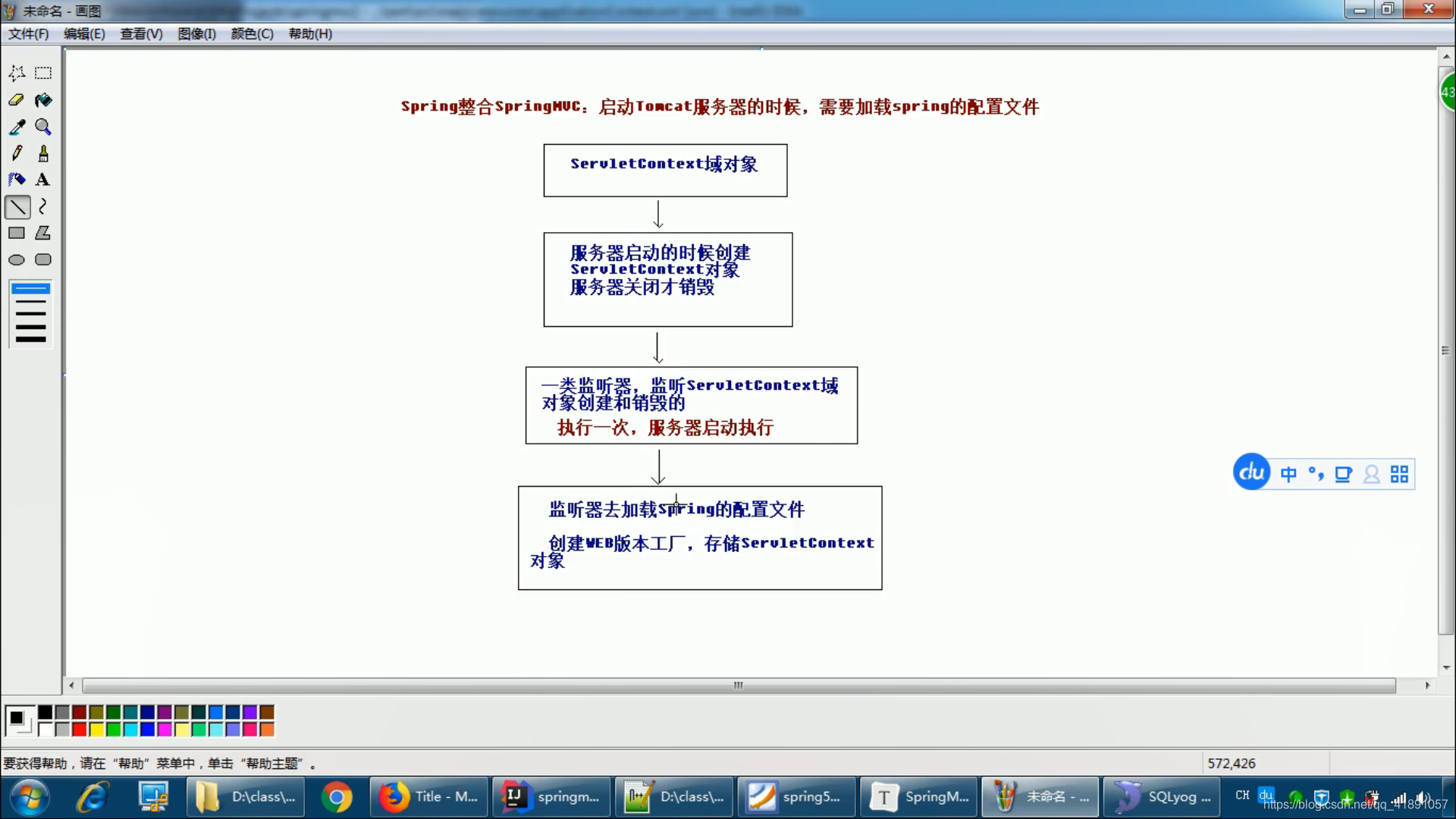搭建整合环境
- 整合说明:我们通常使用Spring框架来整合SpringMVC和Mybatis,且使用注解+XML的形式
- 整合的思路
- 先搭建整合的环境(porm.xml)
- 先把Spring的配置搭建完成
- 再使用Spring整合SpringMVC框架
- 最后使用Spring整合MyBatis框架
搭建和测试Spring框架
- 创建ApplicationContext.xml文件
<?xml version="1.0" encoding="UTF-8"?>
<beans xmlns="http://www.springframework.org/schema/beans"
xmlns:xsi="http://www.w3.org/2001/XMLSchema-instance"
xmlns:context="http://www.springframework.org/schema/context"
xmlns:aop="http://www.springframework.org/schema/aop"
xmlns:tx="http://www.springframework.org/schema/tx"
xsi:schemaLocation="http://www.springframework.org/schema/beans
http://www.springframework.org/schema/beans/spring-beans.xsd
http://www.springframework.org/schema/context
http://www.springframework.org/schema/context/spring-context.xsd
http://www.springframework.org/schema/aop
http://www.springframework.org/schema/aop/spring-aop.xsd
http://www.springframework.org/schema/tx
http://www.springframework.org/schema/tx/spring-tx.xsd">
<!--Spring框架只需要负责业务层和持久层即可,controller由SpringMVC框架来负责-->
<context:component-scan base-package="service"></context:component-scan>
<context:component-scan base-package="dao"></context:component-scan>
</beans>
- 在测试类中测试业务层方法
public class TestSpring {
private AccountService accountService;
@Before
public void init(){
ApplicationContext ac=new ClassPathXmlApplicationContext("ApplicationContext.xml");
accountService = ac.getBean("accountService", AccountService.class);
}
@Test
public void testSpring(){
accountService.findAll();
}
}
搭建和测试SpringMVC框架
- 在web.xml中配置DispatcherServlet前端控制器、编码过滤器
<!--配置编码过滤器-->
<filter>
<filter-name>encoding</filter-name>
<filter-class>org.springframework.web.filter.CharacterEncodingFilter</filter-class>
<init-param>
<param-name>encoding</param-name>
<param-value>UTF-8</param-value>
</init-param>
</filter>
<filter-mapping>
<filter-name>encoding</filter-name>
<url-pattern>/*</url-pattern>
</filter-mapping>
<!--配置前端控制器-->
<servlet>
<servlet-name>dispatcherServlet</servlet-name>
<servlet-class>org.springframework.web.servlet.DispatcherServlet</servlet-class>
<init-param>
<param-name>contextConfigLocation</param-name>
<param-value>classpath:SpringMVC.xml</param-value>
</init-param>
<load-on-startup>1</load-on-startup>
</servlet>
<servlet-mapping>
<servlet-name>dispatcherServlet</servlet-name>
<url-pattern>/</url-pattern>
</servlet-mapping>
- 创建SpringMVC.xml的配置文件,编写配置文件
<?xml version="1.0" encoding="UTF-8"?>
<beans xmlns="http://www.springframework.org/schema/beans"
xmlns:mvc="http://www.springframework.org/schema/mvc"
xmlns:context="http://www.springframework.org/schema/context"
xmlns:xsi="http://www.w3.org/2001/XMLSchema-instance"
xsi:schemaLocation="
http://www.springframework.org/schema/beans
http://www.springframework.org/schema/beans/spring-beans.xsd
http://www.springframework.org/schema/mvc
http://www.springframework.org/schema/mvc/spring-mvc.xsd
http://www.springframework.org/schema/context
http://www.springframework.org/schema/context/spring-context.xsd">
<!--扫描Controller包下的注解-->
<context:component-scan base-package="controller"></context:component-scan>
<!--开启SpringMVC的注解支持-->
<mvc:annotation-driven></mvc:annotation-driven>
<!--视图解析器-->
<bean id="viewController" class="org.springframework.web.servlet.view.InternalResourceViewResolver">
<property name="prefix" value="pages/"></property>
<property name="suffix" value=".jsp"></property>
</bean>
<!--静态资源不过滤-->
<mvc:resources mapping="/js/**" location="/js/"></mvc:resources>
<mvc:resources mapping="/css/**" location="/css/"></mvc:resources>
<mvc:resources mapping="/images/**" location="/images/"></mvc:resources>
</beans>
- 创建AccountController类,编写方法,进行测试
@Controller
public class AccountController {
@RequestMapping("testMVC")
public String testMVC(){
System.out.println("testMVC执行了!");
return "success";
}
}
Spring整合SpringMVC框架
-
目的:在controller中能成功的调用service业务层对象中的方法。
-
整合原理

-
实现步骤
- 在项目启动的时候,就去加载applicationContext.xml的配置文件,创建好容器
- 在web.xml中配置ContextLoaderListener监听器(该监听器默认只能加载WEB-INF目录下的applicationContext.xml的配置文件)
- 在controller中注入service对象,调用service对象的方法进行测试
<!--
配置Spring的监听器(监听ServletContext域对象的创建与销毁)
当ServletContext域对象被创建(服务器一开启),默认加载WEB-INF下的applicationContext.xml文件
但是我们的Spring的配置文件在类路径下
需要配置加载类路径下的配置文件,使用<context-param>标签
-->
<listener>
<listener-class>org.springframework.web.context.ContextLoaderListener</listener-class>
</listener>
<!--配置加载类路径下的配置文件-->
<context-param>
<param-name>contextConfigLocation</param-name>
<param-value>classpath:ApplicationContext.xml</param-value>
</context-param>
@Controller
public class AccountController {
@Autowired
private AccountService accountService;
@RequestMapping("testMVC")
public String testMVC(){
System.out.println("表现层:testMVC执行了!");
accountService.findAll();
return "success";
}
}
来源:CSDN
作者:学JAVA好饿
链接:https://blog.csdn.net/qq_41891057/article/details/104680767
